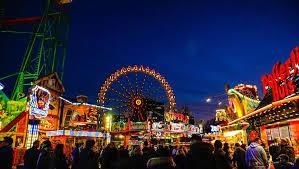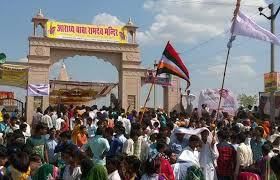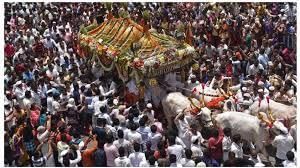Rise of Composite Cultures: Ramdevra and Pandharpur Wari Chapter Notes | Footprints Class 7: Book Solutions, Notes & Worksheets PDF Download
| Table of contents |

|
| Introduction |

|
| Composite Culture |

|
| Case Study: The Festival Celebrating Ramdevji or Ram Shah Pir of Gujarat and Rajasthan |

|
| Case Study: Pandharpur Wari in Maharashtra |

|
Introduction
In India, there are many special festivals that bring people together from different backgrounds. These festivals show how diverse India is, with people living in different ways all across the country.
Key Points
- Ramdevra Mela in Rajasthan: This festival is about celebrating Ramdevji and brings people of different backgrounds together.
- Pandharpur Wari in Maharashtra: This festival celebrates Lord Vitthala and has its roots in a movement from the 13th century called the Bhakti Movement.
- Unity in Diversity: India is a great example of unity in diversity, showcasing various languages, religions, clothing styles, arts, and more.
- Cultural Fusion: The festivals, fairs, and pilgrimages in India reflect a mix of different lifestyles and beliefs, showing how various cultures come together.

Composite Culture
A composite culture is like a mix of different things from various traditions and cultures in one place. It's all about accepting and respecting each other. Let's see how these mixed cultures came about in some areas.
Role of Saints, Philosophers, and Social Reformers
- Starting from the 12th century, there were many special people who tried to solve the problems between different groups. They didn't like the social rules and bad things happening in the name of religion by both Hindu priests and Muslim leaders, especially regarding things like the caste system and how women were treated.
- These special people made a big effort to include the everyday traditions and practices of regular people into their religious activities. They spoke in the language of the locals and followed simple rituals that everyone could understand and join in with. This made everyone feel like they belonged to a bigger group and helped bring different people together, no matter what religion they followed.
Role of Traders and Travelers
Cultures around the world have been influenced by the interactions of traders, travelers, and religious leaders who journeyed to distant lands, encountering new people and customs. This exchange of ideas and practices has played a significant role in shaping composite cultures.
- Merchants' Influence: Traders and travelers like the Hindu Baniyas, Muslim Bohras, and others engaged in extensive trade with various regions, fostering cultural exchange.
- Birth of Composite Culture: The mingling of diverse cultural elements led to the emergence of composite cultures, visible in regions across India by the 15th century CE.
- Impact on Social Structures: The growth of new economic centers gave rise to new groups and communities, including the development of specialized castes and sub-castes.
- Evolution of 'Indianness': The acceptance and integration of diverse cultural influences contributed to the formation of a distinct 'Indianness' in various regions.
Case Study: The Festival Celebrating Ramdevji or Ram Shah Pir of Gujarat and Rajasthan

The stories about Ramdevji go back to the late 14th and early 15th centuries. He was a ruler from the Tanwar Rajput clan, which had emerged in the 12th century. Ramdevji was known for his miraculous abilities and was seen as a protector, especially for those considered "untouchables," women, and the most disadvantaged people in a caste-based society. He is famous for uniting Hindus and Muslims in the region, promoting peace, justice, and equality for everyone. Ramdevji, known as Ram Shah Pir among Muslims, is deeply respected and loved for his compassion for the poor and the marginalized, and he is considered a saint by both Hindus and Muslims.
An Evolving Folk Deity
- Ramdevji is worshipped as a folk deity, and his footprints, known as pagliya, are placed on high platforms under trees in villages. His followers, called Kamadia Panthis, include wandering poets and musicians who sing praises of Ramdevji.
- The priests in Ramdev temples mostly come from the Bhambi community, traditionally regarded as a lower caste. Today, many also see Ramdevji as an incarnation of Lord Krishna.
The Ramdevra Mela
- The Ramdevra Mela is held in the village of Runicha in the Jaisalmer district and is one of the most celebrated festivals in the region. People from various castes, creeds, and religions come together at the Mandir Shri Ram Dev Ji shrine every year during the monsoon months of Sawan and Bhadon, typically between the 2nd and 11th days of these months (August and September).
- Around 5 million people attend this fair, according to the Ramdevra Samadhi Samiti. The temple complex at Mandir Shri Ram Dev Ji is a symbol of social inclusion and cultural unity, where devotees offer rice, coconuts, churma, and cloth or wooden horses as offerings to Ramdevji.
A Unifying Culture
- Ramdevji is one of the five pirs of Rajasthan, along with Pabuji, Harbhuji, Mehaji, and Gogaji. A closer look at their legends shows that they all share a common regional culture, often portrayed as horse riders and protectors in various situations, from snake bites to plagues and other misfortunes.
- They are celebrated for their bravery and heroism, traits often associated with the people of Rajasthan. These figures are seen as local heroes and social reformers who opposed the caste system, rigid religious practices, and any form of division.
- Temples dedicated to Ramdevji can be found across western Rajasthan, parts of Gujarat, and in Sindh, Pakistan, from Pipli Dham in Gujarat to the town of Tando Allahyar in Sindh. These temples attract thousands of devotees from different regions, emphasizing that such traditions are born out of shared histories and cultural connections.
- As people migrated from one region to another, they brought their own cultures with them and adopted elements of the cultures in their new homes. This blending of cultures led to the unique multiculturalism that is a source of pride in India.
Case Study: Pandharpur Wari in Maharashtra

Pandharpur Wari is a significant festival in western India that represents the blending of devotional traditions and folk culture. Located in the Solapur district of Maharashtra, Pandharpur is a town of great historical importance, with its earliest mention found in an inscription from 516 CE.
The Temple of Lord Vitthala
- Pandharpur is renowned for the temple of Lord Vitthala, who is considered a form of Lord Vishnu, along with Devi Rukmini.
- The town is rich in stories and legends, with Lord Vitthala originally worshipped as a cattle god.
- Today, however, he is widely revered as an incarnation of Lord Krishna.
Influence of the Bhakti Movement
- Pandharpur gained special significance during the Bhakti Movement, starting in the 13th century. The rise of the Warkari Panth, a sect within the Bhakti tradition, and the arrival of Bhakti poet Sant Dnyaneshwar, turned Pandharpur into a cultural and spiritual center.
- Other Bhakti poets, like Sant Namdev and Sant Tukaram, further enhanced the town's reputation by preaching and taking samadhi there.
Warkaris (Pilgrims) of Pandharpur
- Pandharpur, also known as part of Dakshin Kashi or Dakshin Dwarka, is the main seat of the Warkari Panth. Devotees from this sect undertake a wari (pilgrimage) on foot to the temple of Lord Vitthala.
- These processions occur four times during the Hindu calendar year. This 800-year-old tradition is the essence of the Warkari Panth. Warkaris travel to the town carrying padukas (footprints) in a palki (palanquin), along with idols on bullock carts and horse chariots, bearing images of saints.
- These saints, mostly from the so-called lower castes, were central to the Bhakti tradition that challenged rigid social norms and uplifted ordinary people. Even after hundreds of years, these saints remain alive in people's minds through their writings and teachings.
Pandharpur Today
- Today, Pandharpur is a unique town that blends faith, legend, folklore, history, and tradition, making it a special place in India's cultural landscape.
- It is not only a center for the integration of different religious sects within Hinduism but also a place where Marathi and Kannada languages coexist.
|
32 videos|247 docs|40 tests
|
FAQs on Rise of Composite Cultures: Ramdevra and Pandharpur Wari Chapter Notes - Footprints Class 7: Book Solutions, Notes & Worksheets
| 1. What is the significance of the Festival Celebrating Ramdevji or Ram Shah Pir of Gujarat and Rajasthan? |  |
| 2. How is the composite culture reflected in the Pandharpur Wari in Maharashtra? |  |
| 3. How did the rise of composite cultures like Ramdevra and Pandharpur Wari contribute to social harmony in India? |  |
| 4. What are some common rituals and practices observed during the Festival Celebrating Ramdevji and Pandharpur Wari? |  |
| 5. How do festivals like Ramdevra and Pandharpur Wari promote cultural exchange and integration in India? |  |




















